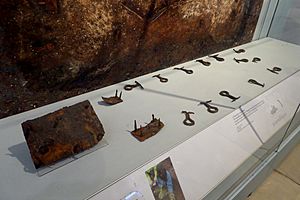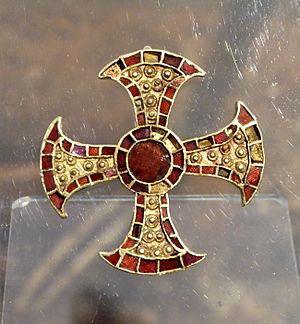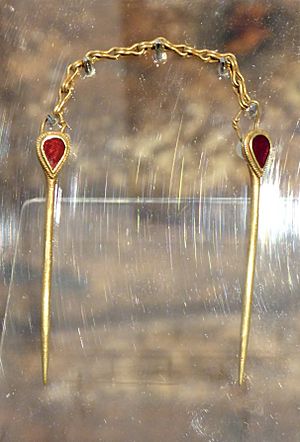Trumpington bed burial facts for kids
| Location | Trumpington, Cambridgeshire, England, United Kingdom |
|---|---|
| Coordinates | 52°10′19″N 00°06′18″E / 52.17194°N 0.10500°E |
| Type | Tomb |
| History | |
| Periods | Anglo-Saxon |
| Site notes | |
| Excavation dates | 2011 |
The Trumpington bed burial is a special Anglo-Saxon grave found in 2011. It dates back to the mid-7th century. This ancient burial site is located in Trumpington, Cambridgeshire, England.
It's important because it's a rare "bed burial." This means the person was buried on a wooden bed. Also, an amazing gold cross was found in the grave. This cross is called a pectoral cross and has shiny red garnet stones.
The Fitzwilliam Museum in Cambridge wanted to buy the cross. However, a company called Grosvenor gave it to the Museum of Archaeology and Anthropology, University of Cambridge in 2018. Experts think the cross is worth more than £80,000.
Who Was Buried Here?
The grave held the body of a young woman. She was about 16 years old when she died. She was placed on a wooden bed, which has now decayed. We know it was a bed because of the iron parts that held it together.
She was buried with several items, known as grave goods. These included an iron knife and a chatelaine. A chatelaine is a chain worn at the waist. It was used to hold useful items like keys or tools. There were also glass beads, which might have decorated a small purse.
The most exciting find was the gold pectoral cross. It was found resting on her chest. The cross is small, only about 3.5 cm wide. It has beautiful red garnets set into it. Small loops on the back of the cross show it was sewn onto her clothes.
Finding the Trumpington Grave
Archaeologists found this bed burial in the summer of 2011. They were digging in Trumpington Meadows, near Cambridge. This work happened before new houses were built there. The team from the Cambridge Archaeological Unit found many old things.
They discovered items from different time periods. These included two long burial mounds from the early Neolithic age. They also found a double burial from the Beaker culture and an Iron Age settlement.
The Anglo-Saxon graves were found in a field north of the meadows. Other Anglo-Saxon features were also discovered. These included sunken floored buildings. Two of the other graves held young women, like the bed burial. However, these other graves did not have beds or any special items.
Experts believe these buildings and graves were part of a settlement. It might have been a religious community. Before this discovery, no early Anglo-Saxon settlement was known in Trumpington.
Why This Discovery Is Important
Bed burials are very rare from the Anglo-Saxon period. Only about a dozen have been found, and most of them are for women. Other bed burials have been found in places like Coddenham, Collingbourne Ducis, and Loftus.
Gold pectoral crosses with jewels are also very uncommon. Only five other similar crosses are known. One of these is on St Cuthbert's coffin. The person who owned this cross was likely from a noble family. They might even have been part of a royal family.
Another bed burial with a pectoral cross was found in the 1800s in Ixworth. But that discovery was not well recorded. This makes the Trumpington find even more special and important for history.
The cross shows that the young woman was a Christian. But she was also buried with other items that were common in pagan traditions. This suggests her burial happened during a time of change. It was when Anglo-Saxons were moving from pagan beliefs to Christianity.
|





